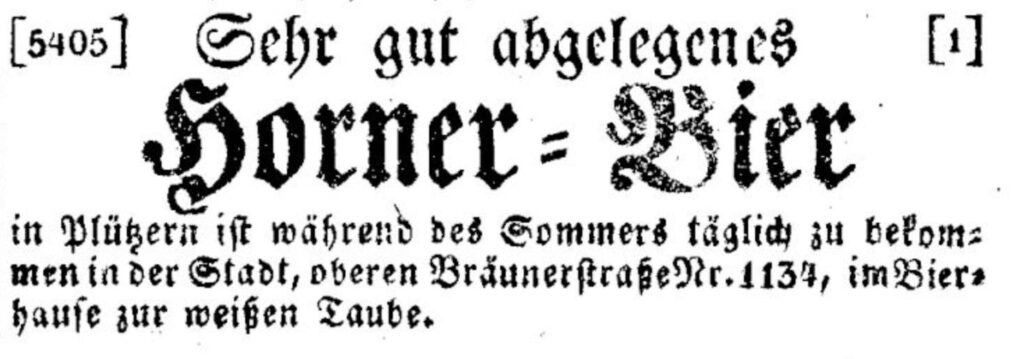Yesterday, August 28, Seedstock Brewery released a pilot batch of their Horner Bier, which makes them the first brewery in over 100 years to do so. Evan Rail wrote an article on VinePair.com about this particular beer style which, while often mentioned in historic beer literature, is so hard to get a grip on. What we basically know about the beer style itself is that it was brewed from oat malt, very pale and quite murky, slightly sour (something that’s been attributed to the use of cream of tartar), highly carbonated and very refreshing.
In my own book, Historic German and Austrian Beers for the Home Brewer, I have a section about Horner Bier. It is one of just two beers for which I was not able to find a complete recipe at the time, so the recipe in the book is just a reconstruction based on educated guesses from the sources that I knew. Previously, I had written down the few things that I knew about about Horner Bier in this blog.
This all got me thinking, and so I went back to researching, going through all the digital libraries that I’ve used in the past, to see whether there were any more details about Horner Bier that I hadn’t been aware of before.
To cut it short: there was not a whole lot of new stuff, in particular nothing that would give any more insight into how the beer used to be brewed. But I found out more things about the culture around this beer.

Horner seems to have been an exclusively bottled beer, very highly carbonated and certainly not cheap compared to other beer types. Most likely because of that, Horner Bier in Vienna in the 18th century and the early 19th century had a similar status of champagne later on, as a drink that somebody would order to display their social status and wealth.
It was served in tightly sealed stoneware bottles which, when opened, would make a banging noise. The type of bottle was called a “Plutzer”, a term also used to describe a big head. Due to the banging noise, it was also called a “Kracher” (banger). Due to its very pale colour and slight sour taste, it was compared with Berliner Weisse.
One source claims that the beer style was allegedly invented in 1750 by a brewmaster called Faber. After his death, the exclusive privilege to brew this beer was rescinded and other brewers copied it, in some cases poorly, and so over time, the quality deteriorated and the beer style lost its high status. This may have been the reason why some people decided to grate a bit of nutmeg into their Horner Bier to improve its flavour.
Horner Bier brewing was definitely not just limited to Horn itself: in Droß, a town about 30 km south of Horn, a brewmaster named Meier was reported to have exported very little of his Horner Bier to Vienna in 1803 because of rising prices, possibly due to taxation.
It’s not even clear when Horner Bier stopped being made. In 1849, an article claimed that the last Horner was brewed 20 years ago. But this seems too early, as we can find ads for “well-matured Horner Bier” in newspapers as late as 1836 (the same page is interesting in that it seems to be dominated by ads for wine, a good example for how popular wine used to be in Vienna before the advent of lager beer).
Horner Bier brewing eventually did cease. In 1878, a new tenant of the Horn brewhouse was mentioned as brewing excellent beer. Despite the allusion to Horner Bier’s past reputation, which older beer drinkers seem to have still remembered at that time, it is not clear whether this was an attempt of a revival of Horner Bier, or just a local brewer trying to build on the past reputation. Even if it was a Horner Bier revival, it didn’t last long. In 1888, the brew house tenant ceased operation, and focused on reselling beer from Schwechat, i.e. Vienna Lager.
And this is all I’ve been able to find out about Horner Bier, the historic oat beer that eludes us all.

Thanks for the extra information. If you would like a bottle please drop us a request.
Frank @ Seedstock brewery. Com